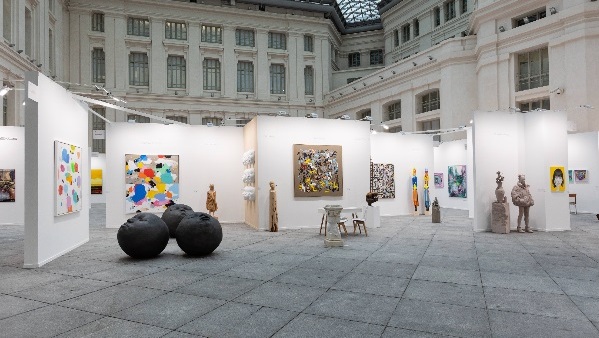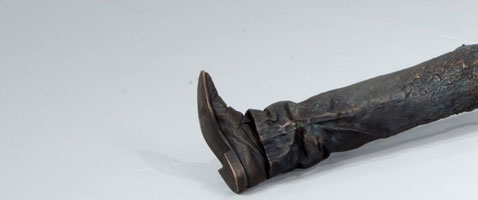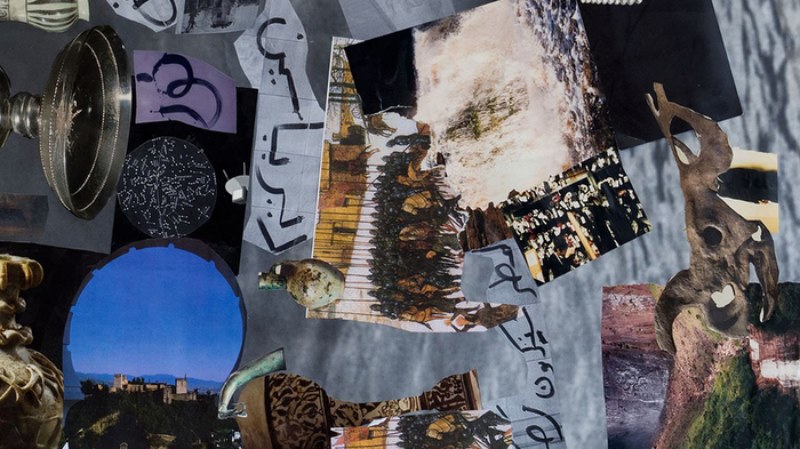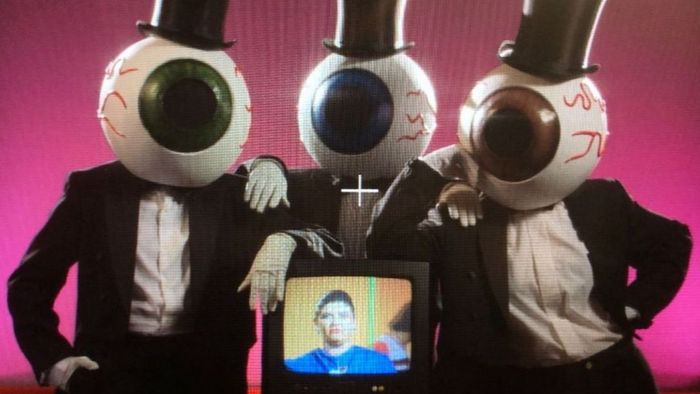By Jorge Fernandez Torres
(Director of the Wifredo Lam Center of Contemporary Art and the Havana Biennial)
The fact that four artists from Cuba are taking part at the Venice Biennial is undoubtedly quite relevant. The Pavilion’s General Curator Miria Vicini’s effort was essential to materializing the project.
The Cuban artists are Alexandre Arrechea, Yoan Capote, Duvier del Dago and Eduardo Ponjuan. The generational differences existing among them do not pose a limitation to their tackling common topics and finding out a discourse that enables them to communicate with each other.
The concept of museography that we conceived is in tune with the title of this year’s Venice Biennial: Illuminations, which implies a reflection about the present-day way of seeing and registering art processes in a world where the cartographies that used to be established in this type of events are fading away. Symbols are becoming more international every day with a dynamic that goes beyond geographic boundaries and that determines what is inclusive and exclusive at the same time.
The Cuban artists have assumed this physical and existential trip as the reason behind their discursive strategy. Even though their insular origins may still lie deep inside them, their coasts belong to the universe. Parodic, poetic and ironic elements do not respond to a nostalgic enunciation, because they are sensing the world. In these creators, tradition is not limited to showing key references of the place they belong to by birth. Their proposals go through international ways of doing without avoiding though the authenticity that results from putting the load of the context they form part of down on to their works.
Within such dynamics, all the pieces in the Biennial embrace the object and its redefinition to activate the space and play around with its secularity. By using playful resources as starting point the immateriality or position of industrial productions as oppose to the ambiguity generated by art could be questioned. Stating a new subjectivity is rethinking the relationship with objectivity. The sculptural value is not limited to the material’s hardness or lightness.
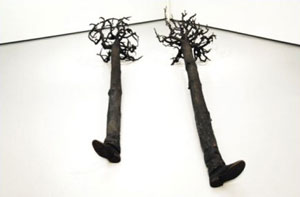 It acquires a status that brings it closer to a performance. The visual traps set in the representation set a contrast with each other and involve the contradictions between precariousness and visual hedonism. In fact it also gives way to questioning how people see Cubans and the visual and conceptual expectations regarding Cuban art.
It acquires a status that brings it closer to a performance. The visual traps set in the representation set a contrast with each other and involve the contradictions between precariousness and visual hedonism. In fact it also gives way to questioning how people see Cubans and the visual and conceptual expectations regarding Cuban art.
The exhibition of the four Cuban artists begins at the gardens of the San Servolo Island. A work by Yoan Capote titled Migrant has been placed there. The sculptures’ monumentality doesn’t make us see the size of the pieces as an isolated fact. The work mirrors the suffering of those living in a culture other than their own. Next to the huge structures is also Tierra de Cuba (Land from Cuba). By placing an organic material in front of one that is industrially processed, barriers between reality and fantasy are brought down and the reality-fiction duality is dissolved. Capote is not interested in exploring a cause and effect system; he would rather find his way into the ontological, into what belongs to the nature of the being.
As enter the Pavilion, we come across, in hall A, with Alexandre Arrechea’s The city that Stopped Dancing. Three spinning tops functioning as the base for three buildings that are part of the Cuban history: the Bacardi building, 1930; the Someillán, 1950s and the Russian Embassy, 1970s. The artist, through architecture, ponders over the self-genesis of power and its seducing illusions. The grandiloquence of formal dazzle is structured by the object’s sort of impersonality that awakens a critical look in the individual. The exquisiteness of the piece does not hide the provocation and enquiry of the forms establishing the visual hierarchy levels. Finally, it is easy to perceive the risky and volatile nature of the bases holding things up. Architecture is a memory where the true symbolic value of a given period is at stake, together with the mark it leaves behind when it starts to be seen as history or past. The new political and economic relations are the ones that institute the site. Everything takes place and is destroyed at the same time to give way to standardization which absorbs the actual sense of things.
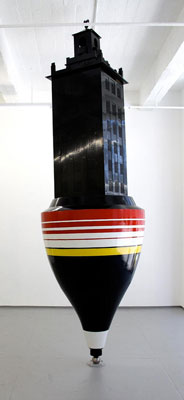 Marking the Center of the room there is a piece by Eduardo Ponjuan titled South where the magnetic north and its displacements are defined. Through this ancient object coming from thousand-year-old China and used for orientation by so many sailors out at sea, the artist introduces a wide range of meanings. The title of the piece acquires a polysemous richness on each different context. The physical and astronomic contradictions between the north magnetic pole and the north cardinal point are revealed to demonstrate the relativity and differences in geopolitics. The names of First, Second and Third world are replaced with the North-South which at the same time come closer to the former notion of center and periphery. Ponjuan adds new readings to the piece by connecting it with Italy and the Venice Biennial.
Marking the Center of the room there is a piece by Eduardo Ponjuan titled South where the magnetic north and its displacements are defined. Through this ancient object coming from thousand-year-old China and used for orientation by so many sailors out at sea, the artist introduces a wide range of meanings. The title of the piece acquires a polysemous richness on each different context. The physical and astronomic contradictions between the north magnetic pole and the north cardinal point are revealed to demonstrate the relativity and differences in geopolitics. The names of First, Second and Third world are replaced with the North-South which at the same time come closer to the former notion of center and periphery. Ponjuan adds new readings to the piece by connecting it with Italy and the Venice Biennial.
At the end of the tour of the Pavilion, we found Yoan Capote’s Autorretrato (Self portrait). In this piece the artist goes back to a more personal look. The bones of two human legs have to be placed in the right way so they can bear three concrete blocks. Melting the legs imply actual references to the remaining of many people who served as inspiration and model to him. The artist manages to transmit to the viewer the pressure he feels as his own due to the drama. Despite the strong minimalist character of the piece, it is not merely a representation of the purist relation with the material. The work suggests the artist’s humanist stance. Weight is interpreted here with the metaphorical look of a Richard Serra. The physical sturdiness is equaled to that of the mind. This analogy also entails fragility in all of its meanings and in some way refers to the difficulties in handling the life, death and stress generated professional success and social recognition is achieved.
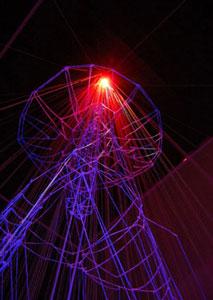 As we walk across hall B we find to the right the piece Aleph by Duvier del Dago. The title owes a lot to Jorge Luis Borges, one of the greatest figures of world literature. The epic journey and the regular trip go through cycles that never end or lead to anywhere. Imagination and the part of the world that can be represented are conceived in the cohesion of thinking and the ability to foil our idea of wanting to name reality and record its supposed presence. Duvier uses threats worked with black light to show the records of a GPS sign. In these works, he creates an interesting complicity between scarcity and technology, between the immaterial and the material. He is not interested in setting up a scene of dualities that complement each other. He seeks to question stances implying any form of establishing or instituting control. The piece champions individuals’ freedom and their need to find their own options. It goes beyond the boundaries of places to present a problem that lies in the genesis of the social contract, so fiercely defended since the very origins of modern thinking.
As we walk across hall B we find to the right the piece Aleph by Duvier del Dago. The title owes a lot to Jorge Luis Borges, one of the greatest figures of world literature. The epic journey and the regular trip go through cycles that never end or lead to anywhere. Imagination and the part of the world that can be represented are conceived in the cohesion of thinking and the ability to foil our idea of wanting to name reality and record its supposed presence. Duvier uses threats worked with black light to show the records of a GPS sign. In these works, he creates an interesting complicity between scarcity and technology, between the immaterial and the material. He is not interested in setting up a scene of dualities that complement each other. He seeks to question stances implying any form of establishing or instituting control. The piece champions individuals’ freedom and their need to find their own options. It goes beyond the boundaries of places to present a problem that lies in the genesis of the social contract, so fiercely defended since the very origins of modern thinking.
Room B is closed with Hundido en la línea del Horizonte (Sunken in the Horizon Line) by Eduardo Ponjuan. A row of kilos, the smallest coin in Cuba worth one cent, hooked to a one-peso coin from 1934. The installation also generates tension; the infinite island that has accompanied the Cuban literature and art is attached to it. Although simple in composition, the way it is staged and the nature of the material employed generate diversity on its symbolic reading. Art always comes before social commotions. At the moment of economic crises and when politics give in to financial lobbying, this piece emerges where ethical and aesthetic elements share a special mysticism: we never know which border we are crossing over. That’s the mystery of Horizontes. There is not a set course.
 Here the territory is empty. Certain nomadism makes us play with a possible not-well-defined barrier. We are standing in many starting and returning points at the same time. Ponjuan summons us to come back on ourselves and think about our own taboos. The line marked by his work continues to contain Ives Klein’s Empty Jump enigma. We experience events that have already happened and those that will never happened at the same time.
Here the territory is empty. Certain nomadism makes us play with a possible not-well-defined barrier. We are standing in many starting and returning points at the same time. Ponjuan summons us to come back on ourselves and think about our own taboos. The line marked by his work continues to contain Ives Klein’s Empty Jump enigma. We experience events that have already happened and those that will never happened at the same time.
All the pieces are united by both balance and imbalance; they embrace the journey, the memory and the need to establish a visibility about a context that outlines a course that doesn’t end in the anecdote. They question us about the differences between seeing and watching. More than an illumination, what they seek is to generate other levels of understanding the attitude of creation within life.
CUBA at the 54th Venice Biennial
June 4 – November 27, 2011
Sunday 5.29.2011
* In addition to the four Cubans participating in the exhibition Cuba mon amour: Yoan Capote, Alexandre Arrechea, Eduardo Ponjuan and Duvier del Dago; at the Italian-Latin American Pavilion young Cuban artist, Reynier Leyva Novo, is taking part in the region’s collective exhibition about the Bicentennial: Between always and ever; as well as renowned Alexis Leyva (Kcho).
Related Publications
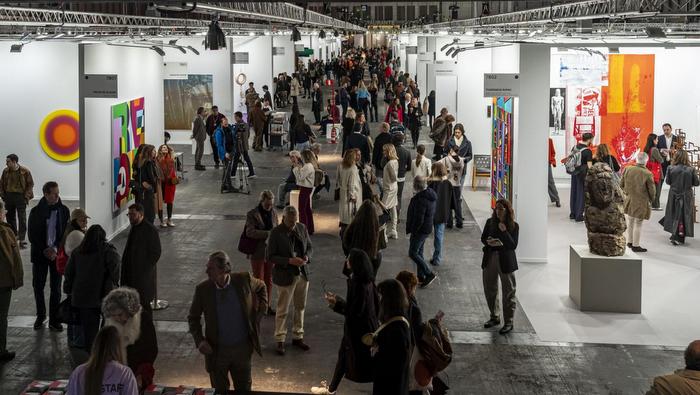
ARCOmadrid announces the participating galleries in its 45th edition
December 19, 2025